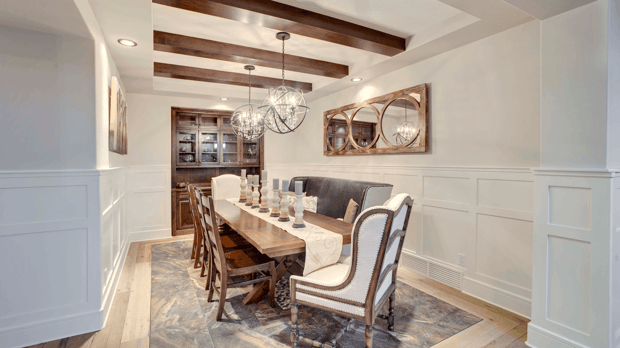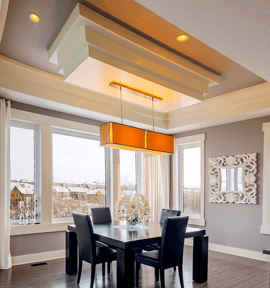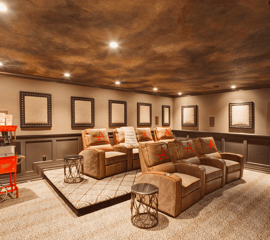 When you're dreaming up the design of your brand new home, things you consider will likely include the layout and design of your ideal kitchen, your favourite flooring, and an overall colour scheme you've always wanted.
When you're dreaming up the design of your brand new home, things you consider will likely include the layout and design of your ideal kitchen, your favourite flooring, and an overall colour scheme you've always wanted.
You'll likely choose a stunning stone for your fireplace, and choose the right style of hardwood to define your great room space. But there is one space in your home you might be forgetting about. When designed with careful thought and planning, it can change the entire look and feel of your home.
Look up!
Your ceiling treatment can be so much more than a simple choice between popcorn and California Knockdown. This "fifth wall" holds incredible potential to set the bar for the design of the rest of your home.
We have some ideas on how you can break the barrier and treat your ceiling as the work of art it deserves to be.
Coffered
A coffered ceiling, in general terms, is a pattern of beams installed to create a grid. It's a finish often seen in Victorian homes with stunning crown moulding and detail work. Today, its application can be done in a wide variety of different ways depending on the look you want to achieve, ranging from its original Victorian style design to something more clean and modern.
A simple design more fitting of the modern style would be minimalist painted coffers with no trim work installed. This design still gives the coffered look but doesn't drown the style with too much detail. Paint the coffers a feature colour, perhaps from a popular paint palette, while retaining the white or off-white ceiling tone inside the insets. You can choose to have a smooth finish in your insets, or treat them with the usual Knockdown or popcorn (if you like this texture.)
To add more detail to your coffers, you can do a little or a lot in trim work. Add crown moulding inside the insets, or clad the entire grid system in stunning wood trim. Add pot lights in the insets for lighting if you choose, and if your grid system allows a centred light fixture, finish the room with a magnificent chandelier or other high-end custom lighting options.
 Tray
Tray
Tray ceilings add beautiful depth and texture to your room by wrapping the perimeter of the room in a dropped design. This could be simple ceiling drops by 6" around the edges of the room, creating the look of higher ceilings, or it could be more detailed with underlighting or multiple levels of depth.
The inset in a tray ceiling offers the opportunity to add texture and pattern using special paint application, wallpaper, or stencilling. The possibilities in tray ceiling design are virtually endless, and really quite spectacular when executed the right way.
Stripes
If you like pattern — like, really like it — this ceiling finish is a new trend in home design. A smooth-finished ceiling can be painted with various widths of stripes in either high-contrast colours or more subtle transitions depending on your look.
These stripes can stretch the entire length of the room or can be part of a tray ceiling design as the inset. This design isn't for the faint of heart, but if you have a bold and daring personality, this might be the ceiling treatment you're looking for.
Ceiling Textures of Varying Kinds
Instead of leaving your ceiling as simply drywall, there are many other materials and textures you can add to make the room feel more finished. Add a Knockdown type texture to a ceiling painted a different colour, perhaps a warmer tone to bring out the tones in the flooring opposite the ceiling. The lighting you choose can also have an effect on the appearance of textures.
A wooden ceiling will create a warmer atmosphere. Depending on the size and shape of the room, this could be a wooden finish in the inset of a tray ceiling, installed like hardwood flooring. It could also be a continuation of wooden beams by adding wood panels between the beams. This can be done tastefully, and won't look like an old 1970's cabin.
Beams
If you have vaulted ceilings and love the open rafter (or farmhouse) type look, natural wood beams can play a significant role in highlighting your home's architecture. While vaulted ceilings on their own can sometimes feel cavernous, adding beams that stretch across the expanse of the space can visually bring the ceiling down to a cozier level, while still maintaining the openness of the vault.
These beams can be any type of material. Traditionally, they're reclaimed wood or rough wood finish. Alternatively, they can be painted medium-density fibreboard (MDF) if it's just the shape you're looking for in a more subtle application. This type of look usually carries a strong "wow" factor in the home.
Beams can also be installed in a variety of different ways to achieve different looks. They can be installed flush to the ceiling to define the shape or add contrast to the design. They can be installed at the joint where your wall meets the ceiling and stretch across the space to create a faux flat ceiling look. They can also be used to create coffers, although this should really be done only if your ceilings are 10' or higher as the look can make rooms feel smaller.
The ceilings in your home offer so much potential to contribute to the overall design of your home. Choose a room in your home that deserves a spectacular ceiling treatment such as the great room, bonus room, or even formal dining room. Whatever you do with your ceilings will keep you looking up!





